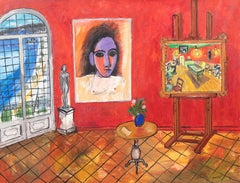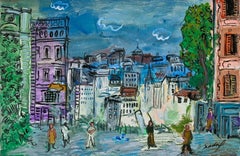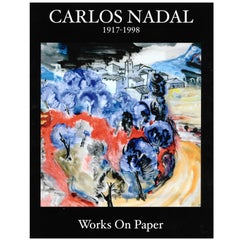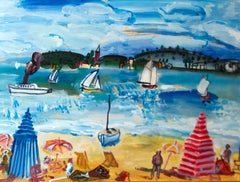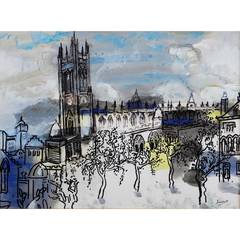Nadal Carlos
1980s Fauvist Landscape Paintings
Oil, Canvas
1990s Modern Figurative Paintings
Canvas, Oil
20th Century Impressionist Landscape Paintings
Canvas, Oil
20th Century Books
Paper
Recent Sales
1970s Paintings
Paper, Oil
20th Century Contemporary Landscape Drawings and Watercolors
Mixed Media, Paper
1980s Fauvist Figurative Paintings
Canvas, Oil
1980s Fauvist Landscape Paintings
Canvas, Oil
1980s Fauvist Figurative Paintings
Canvas, Oil
1980s Fauvist Figurative Paintings
Canvas, Oil
1970s Fauvist Landscape Paintings
Canvas, Oil
1990s Fauvist Interior Paintings
Canvas, Acrylic
1970s Fauvist Landscape Paintings
Acrylic
1980s Fauvist Figurative Paintings
Oil, Cardboard
1990s Fauvist Landscape Paintings
Canvas, Acrylic
1990s Fauvist Landscape Paintings
Canvas, Mixed Media
1980s Fauvist Figurative Paintings
Canvas, Mixed Media
1970s Fauvist Figurative Paintings
Canvas, Acrylic
1950s Post-Impressionist Landscape Paintings
Canvas, Oil
1970s Fauvist Figurative Paintings
Canvas, Paper, Acrylic
Late 20th Century Fauvist Figurative Paintings
Oil
People Also Browsed
2010s Italian Mid-Century Modern Wall Lights and Sconces
Brass
21st Century and Contemporary Vietnamese French Provincial Dining Room T...
Wood
21st Century and Contemporary Surrealist Figurative Paintings
Oil
Antique 19th Century Dutch Dutch Colonial Architectural Elements
Ceramic
Antique Early 1800s English Georgian Beds and Bed Frames
Upholstery, Mahogany
2010s North American Beds and Bed Frames
Cotton
2010s Modern Pillows and Throws
Cotton, Velvet
21st Century and Contemporary Italian Animal Sculptures
Crystal, Gold Plate, Brass
Early 18th Century Old Masters Landscape Paintings
Canvas, Oil
Mid-20th Century Swedish Mid-Century Modern Coffee and Cocktail Tables
Beech
Vintage 1940s Danish Scandinavian Modern Sofas
Leather, Wool, Hardwood
17th Century Old Masters Animal Paintings
Canvas, Oil
2010s American Pillows and Throws
Cotton
Antique Late 19th Century English Victorian Vitrines
Satinwood
21st Century and Contemporary Italian Mid-Century Modern Chandeliers and...
Brass
21st Century and Contemporary Italian Mid-Century Modern Chandeliers and...
Brass
Nadal Carlos For Sale on 1stDibs
How Much are Nadal Carlos?
Carlos Nadal for sale on 1stDibs
Carlos Nadal was born in Paris in 1917. Within four years, his family moved to Barcelona.
Nadal’s father owned a commercial design workshop. There he began to work as an apprentice and learned to paint in his early teens. He took art classes at a school on Barcelona’s Calle Caspe. In 1935 Nadal won three awards, including an award from the Watercolors Association of Barcelona, the Mural Composition Count Lavern and the Masriera prize. A year later, Nadal received a scholarship from the Barcelona City Council and because of which he was able to attend the Escola Superior de Belles Arts de Sant Jordi.
Nadal exhibited for the first time in a collective exhibition at the Galeries Dalmau in 1941, and he had his first solo exhibition at La Pinacoteca in Barcelona in 1944. In 1946 the Barcelona City Council again granted him a scholarship to continue his education in Paris at École des Beaux-Arts. In the French capital, he took part in the Autumn Salons.
In 1948 Nadal married the Belgian sculptor Flore Joris and moved to live in Belgium. Here, he stated that he discovered the effects of light on painting and the use of color that would already be a distinctive sign of his work. The influence of Fauvism on Nadal’s paintings was remarkably clear. There was continuous success for the artist in Belgium and he remained very active, exhibiting there as well as in France, Spain, Amsterdam and the United States. His subjects were varied and included beaches, urban landscapes, natural landscapes, seascapes and more.
In 1954 Nadal exhibited with great success at Kunstverein Düsseldorf and at the Royal Academy in London, and won the painting prize at the International SPA Contest. During the same year, he met Pablo Picasso on the Côte d'Azur and began a great friendship with the artist. Nadal’s work can be found in the Barcelona Museum of Contemporary Art, the Royal Museum of Brussels and more.
Find a collection of Carlos Nadal art on 1stDibs.
(Biography provided by Galeria Luis Carvajal)
Finding the Right Paintings for You
Painting is an art form that has spanned innumerable cultures, with artists using the medium to tell stories, explore and communicate ideas and express themselves. To bring abstract paintings, landscape paintings, still-life paintings and other original paintings into your home is to celebrate and share in the long tradition of this discipline.
When we look at paintings, particularly those that originated in the past, we learn about history, other cultures and countries of the world. Like every other work of art, paintings — whether they are contemporary creations or works that were made during the 19th century — can often help us clearly see and understand the world around us in a meaningful and interesting way.
Cave walls were the canvases for what were arguably the world’s first landscape paintings, which depict natural scenery through art. Portrait paintings and drawings, which, along with sculpture, were how someone’s appearance was recorded prior to the advent of photography, are at least as old as Ancient Egypt. In the Netherlands, landscapes were a major theme for painters as early as the 1500s. Later, artists in Greece, Rome and elsewhere created vast wall paintings to decorate stately homes, churches and tombs.
Today, creating a wall of art is a wonderful way to enhance your space, showcase beautiful pieces and tie an interior design together.
No matter your preference, whether you favor Post-Impressionist paintings, animal paintings, Surrealism, Pop art or another movement or specific period, arranging art on a blank wall allows you to evoke emotions in a room while also showing off your tastes and interests. A symmetrical wall arrangement may comprise a grid of four to six pieces or, for an odd number of works, a horizontal row. Asymmetrical arrangements, which may be small clusters of art or large, salon-style gallery walls, have a more collected and eclectic feel.
Download the 1stDibs app, which includes a handy “View on Wall” feature that allows you to see how a particular artwork will look on a particular wall, and read about how to arrange wall art. And if you’re searching for the perfect palette for your interior design project, what better place to turn than to the art world’s masters of color?
On 1stDibs, you’ll find an expansive collection of paintings and other fine art for your home or office. Browse abstract paintings, portrait paintings, paintings by emerging artists and more today.
